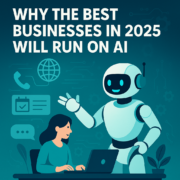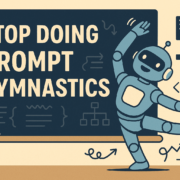The Coming Precision Age: Why Sloppy Language Is a Liability in an AI World
LLMs are quietly forcing us to rethink how we use language.
In everyday conversation, we’re imprecise—and that’s fine. Tone, body language, and shared context do most of the heavy lifting. We throw around words like big, large, huge, enormous as if they’re interchangeable, when in reality they carry distinct levels of scale and intensity.
But that kind of ambiguity doesn’t translate cleanly to machines. LLMs try to read between the lines—but every time they do, they’re making educated guesses based on pattern-matching, not real understanding. And the more they have to guess, the less accurate—or even useful—their response becomes.
Sometimes you get lucky. Other times you get hallucinations.
They don’t actually know what you meant. They only know what your words statistically suggest. That’s a fragile way to run anything mission-critical.
1. We’ve Always Tolerated Vagueness
Human-to-human conversation is a dance of assumptions. We can get away with saying things like “make it pop” or “go big” because the person across from us fills in the blanks using shared experience, personality, and tone.
It’s messy, but it works—because humans are built for messiness. LLMs are not.
They don’t nod politely and pretend to know what you mean. They take your words at face value. And that puts a spotlight on how casual and imprecise most of our language really is.
2. AI Exposes the Gap Between What We Say and What We Mean
The reason people think LLMs are “too agreeable” or “don’t think critically” is often because their prompts didn’t ask for anything more. You tell the AI, “I have a business idea,” and just like your well-meaning friend, it says, “That’s interesting!”
But what you actually wanted was: “Tell me if this is viable. What’s the risk? Who’s the buyer?”
The problem isn’t the model. The problem is the prompt.
AI gives us what we asked for, not what we assumed we were communicating. And that’s a painful but important realization.
3. Language Is Becoming Infrastructure
We’ve never needed to be precise before—not like this. Now we do.
When words become system inputs, they stop being just communication tools. They become infrastructure. And just like sloppy code breaks programs, sloppy language breaks prompts, outputs, and results.
This isn’t a new idea to every field. In law, a single misplaced phrase can rewrite the obligations of a contract. In programming, a missing semicolon can crash a system. In science, precision defines whether a result is valid or nonsense. These disciplines already treat language as structural—because in high-stakes environments, vagueness is a liability.
Now that we’re building with language inside AI systems, we face the same demand. Your prompt is your API call to intelligence. If it’s vague, expect garbage out. If it’s sharp, structured, and contextualized—you unlock serious leverage.
So as we build with AI, we’re not just giving instructions—we’re writing the logic that governs output. The clearer the language, the stronger the system.
4. Precision Is the New Strategic Edge
This shift isn’t about being pedantic. It’s about being effective.
In business, in creativity, in leadership—people who say exactly what they mean, and ask for exactly what they want, move faster. They make better decisions, delegate more cleanly, and get clearer AI output.
The rise of LLMs is revealing something we’ve always suspected: clear thinking and clear speaking are deeply connected. And as more of our tools rely on textual input, that connection becomes a competitive edge.
5. It’s Not About Changing the Machines—It’s About Changing Ourselves
We keep trying to make AI understand us better. But maybe we’re missing the point.
In real life, we cultivate the kind of people we trust to give us honest feedback. If you want a friend who pushes back, you choose someone who challenges you. That becomes their role in your life. You don’t have to remind them every time—that’s the expectation.
With LLMs, that doesn’t happen unless you tell it what kind of “friend” you want it to be. If you want critique, systems thinking, or ruthless clarity—you need to build that into the prompt.
Even with the best friends in the world, problem-solving is still iterative. You talk, they push, you revise. LLMs are no different—it’s not one prompt, one answer. It’s a dialogue you have to shape with care.
So maybe the deeper opportunity here isn’t about training machines to think like us. It’s about us learning to speak more clearly—because now, the cost of ambiguity is measurable.









Leave a Reply
Want to join the discussion?Feel free to contribute!